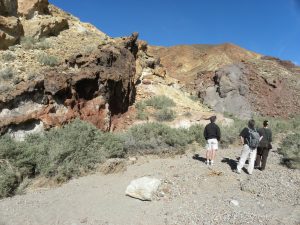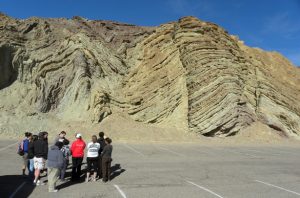The wind is the part of the desert that I miss the most. There is something primal in the desert wind, the way it can go from a feathery touch to hot breath to a raging dust storm in just minutes. The features the wind creates are among the most attractive images in geology. ( “Of all natural forms, sand dunes are the most elegant – so simple, severe, bare. Nature in the nude.” From Desert Images, by Edward Abbey.) Our goal for Friday’s lecture is to understand the wind in the desert: where it comes from and what it does as a geological process.
We’ll start with an overview of eolian (wind) processes, which this physical geography webpage gives us (more or less). What causes the wind in the first place? How do Mojave Desert winds differ from other wind systems? (OK, that poem isn’t so great, but at least you were entertained by the pop-ups. Maybe this Mojave poem by Sylvia Plath is better?) How windy is it in the Mojave Desert right now?
As for the effects of wind in the desert, you’ll certainly want to start with some movies of sand movement in wind tunnels (very exciting, especially the close-ups), and read how some Germans have modeled sand dunes in that classic German way. As for real sand dunes, there are many websites with spectacular photos and descriptions. We will even see one of the famous deposits of “acoustic sands” on our field trip. (Hearing the sound is another story. I’ve heard it only once doing experiments on the Kelso Dunes with my Wooster colleagues.) The movement of sand in deserts is a serious issue, especially when desertification approaches a city, like Nouakchott, Mauritania, in this example.
Finally, we’ll look at the issue of dust derived from deserts by the wind. Loess is a deposit of wind-blown silt or clay. Dust storms have increased in frequency across the globe as deserts have increased and desert soils have been disturbed. This has very worrying health implications. (I grew up, for example, with the constant threat of Valley Fever.) Desert dust storms are even implicated in the decline of coral reefs.
If we have time we may get to talk about the Mojave wind as a renewable energy source — but the topic is presently mired in much debate, with even the military entering in.
Field trip note: This is a good time to review the bring list from the Desert Studies Center. It may be updated later once we get the final paperwork from the DSC.

Geology in the News –
NASA has a great video on the structure of Greenland’s ice sheet, using a variety of techniques, most notably ice-penetrating radar. These scientists have produced a 3-D map of the age relationships of the ice, all the way back to the Eemian.
The Rosetta Probe studying Comet 67-P contnues to provide astounding images of the comet’s surface. Check out these cometary goosebumps and what they may tell us about the origin of this comet billions of years ago.
A new biophysical analysis suggests hadrosaur dinosaurs could outrun Tyrannosaurus rex, at least if given a bit of a headstart. Their engineering would allow them to outlast T. rex in a long distance race. If surprised, though, the hadrosaurs were a quick lunch.









